Abstract
Studies were performed in pregnant rabbits to assess the effect of inhibition of prostaglandin synthesis on uterine blood flow. Cardiac output and uteroplacental blood flow (UPBF) were measured using radiolabeled microspheres. Prostaglandin E (PGE) concentration was measured by radioimmunoassay in the uterine vein and peripheral artery of the pregnant nephrectomized rabbit. Either meclofenamate or indomethacin 2 mg/kg were utilized to inhibit prostaglandin synthesis. Systemic arterial pressure increased from 86 mm Hg to 98 mm Hg (P less than0.0001) after prostaglandin inhibition. Cardiac output was unchanged after the inhibition of prostaglandin synthesis, 326 ml/min to 7.8 ml/min. Uterine vein PGE concentration was extremely high, 172.4 ng/ml, with concomitant peripheral arterial PGE 2.1 NG/ML. Intravenous administration of either meclofenamate or indomethacin reduced uterine vein PGE to 23 ng/ml (P less than 0.01) and arterial PGE to 1.0 ng/ml (P less than 0.05). Male and nonpregnant female rabbits had lower arterial PGE, 0.37 ng/ml (P less 0.05). Studies in non-nephrectomized pregnant animals demonstrated that uteroplacental secretion of PGE was greater than five times renal secretion. These studies demonstrate that the rabbit uteroplacental unit is a rich source of PGE and suggest that production of the vasoactive lipid may have a key role in regulating UPBF during pregnancy.
Full text
PDF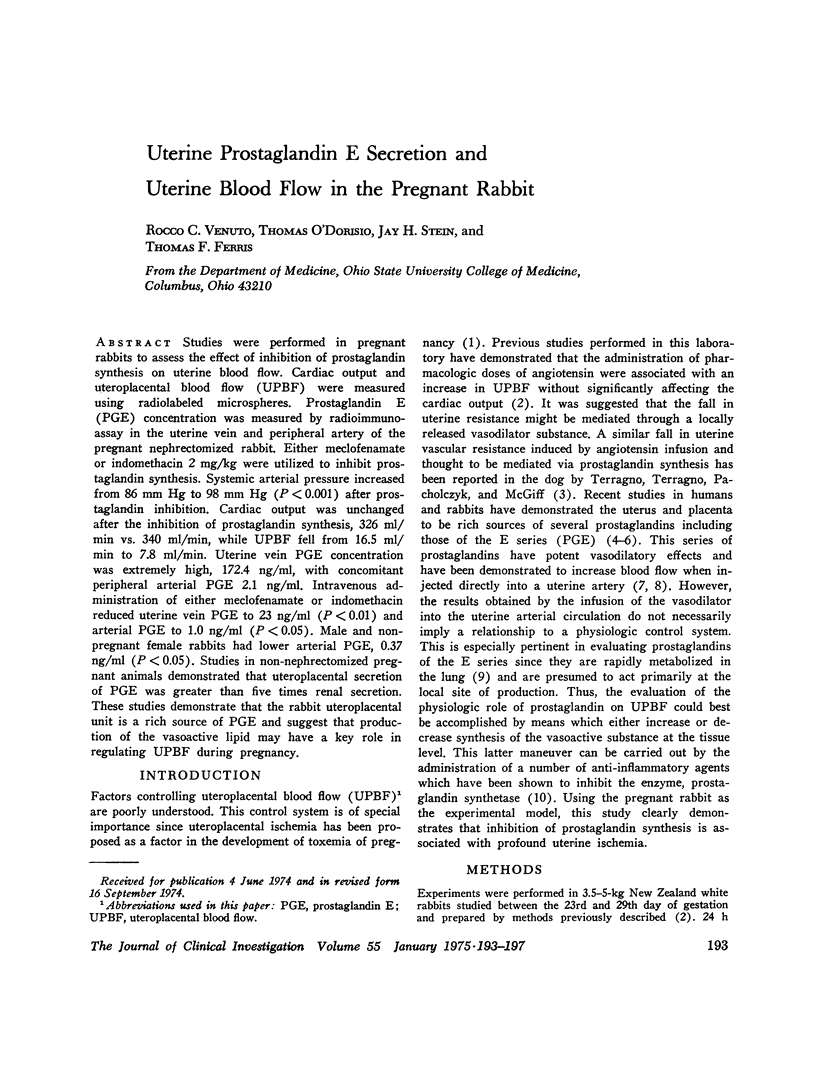
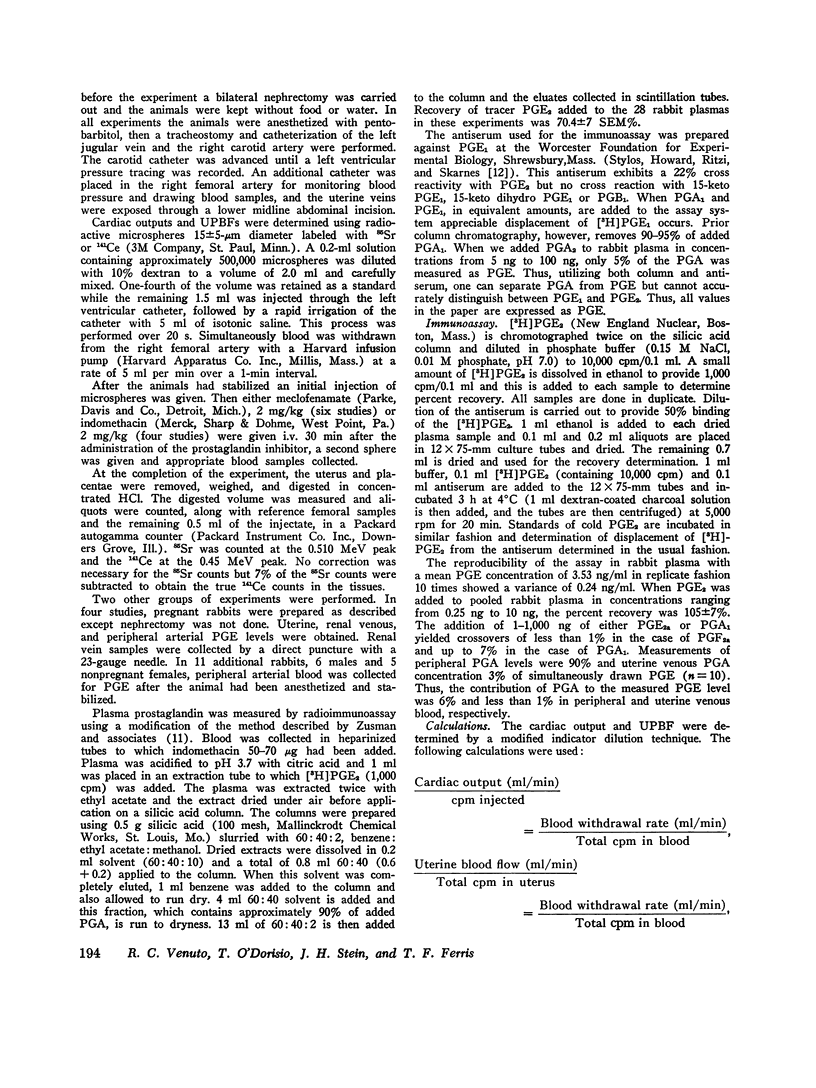
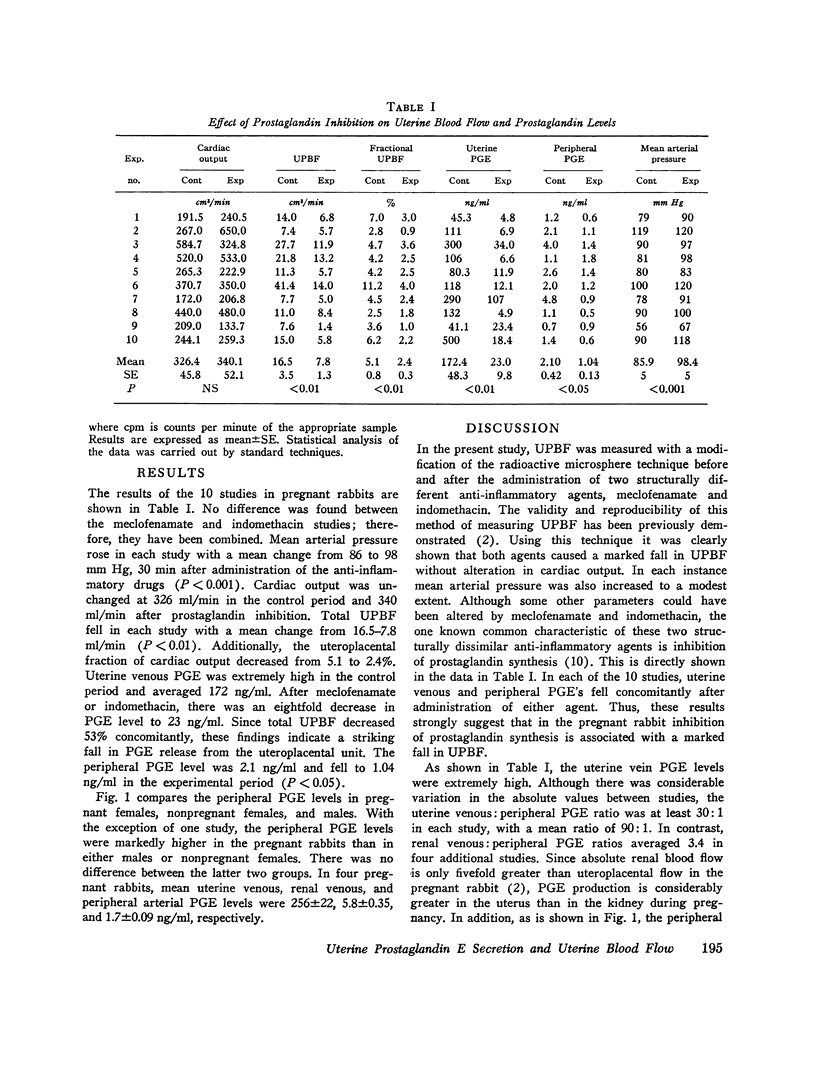
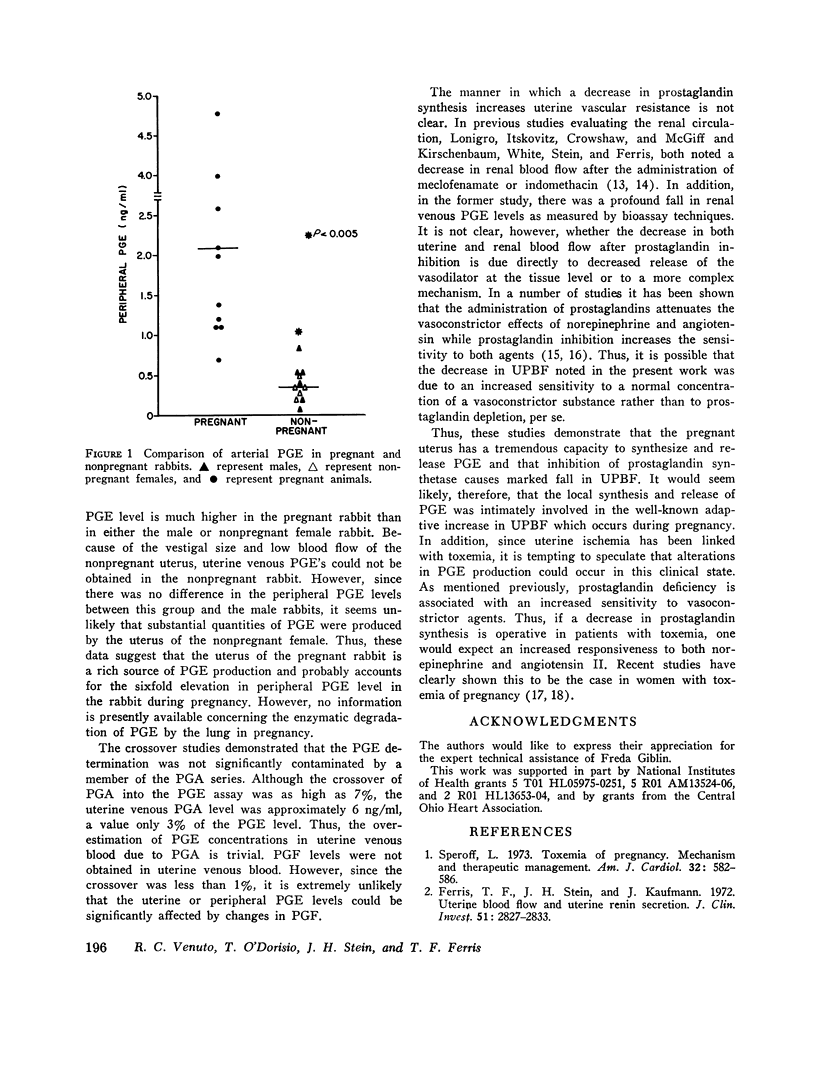
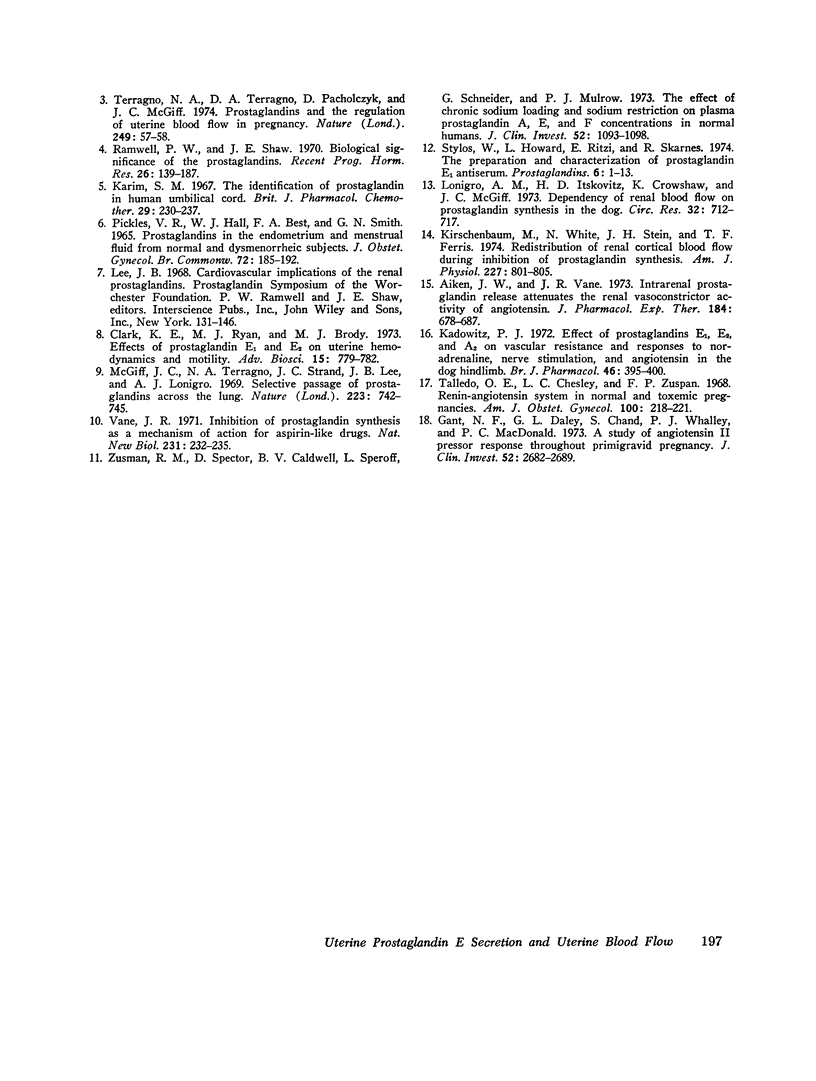
Selected References
These references are in PubMed. This may not be the complete list of references from this article.
- Aiken J. W., Vane J. R. Intrarenal prostaglandin release attenuates the renal vasoconstrictor activity of angiotensin. J Pharmacol Exp Ther. 1973 Mar;184(3):678–687. [PubMed] [Google Scholar]
- Clark K. E., Ryan M. J., Brody M. J. Effects of prostaglandins E1 and F2alpha on uterine hemodynamics and motility. Adv Biosci. 1973;9:779–782. [PubMed] [Google Scholar]
- Ferris T. F., Stein J. H., Kauffman J. Uterine blood flow and uterine renin secretion. J Clin Invest. 1972 Nov;51(11):2827–2833. doi: 10.1172/JCI107105. [DOI] [PMC free article] [PubMed] [Google Scholar]
- Gant N. F., Daley G. L., Chand S., Whalley P. J., MacDonald P. C. A study of angiotensin II pressor response throughout primigravid pregnancy. J Clin Invest. 1973 Nov;52(11):2682–2689. doi: 10.1172/JCI107462. [DOI] [PMC free article] [PubMed] [Google Scholar]
- Kadowitz P. J. Effect of prostaglandins E 1 , E 2 and A 2 on vascular resistance and responses to noradrenaline, nerve stimulation and angiotensin in the dog hindlimb. Br J Pharmacol. 1972 Nov;46(3):395–400. doi: 10.1111/j.1476-5381.1972.tb08136.x. [DOI] [PMC free article] [PubMed] [Google Scholar]
- Karim S. M. The identification of prostaglandins in human umbilical cord. Br J Pharmacol Chemother. 1967 Feb;29(2):230–237. doi: 10.1111/j.1476-5381.1967.tb01955.x. [DOI] [PMC free article] [PubMed] [Google Scholar]
- Kirschenbaum M. A., White N., Stein J. H., Ferris T. F. Redistribution of renal cortical blood flow during inhibition of prostaglandin synthesis. Am J Physiol. 1974 Oct;227(4):801–805. doi: 10.1152/ajplegacy.1974.227.4.801. [DOI] [PubMed] [Google Scholar]
- Lonigro A. J., Itskovitz H. D., Crowshaw K., McGiff J. C. Dependency of renal blood flow on prostaglandin synthesis in the dog. Circ Res. 1973 Jun;32(6):712–717. doi: 10.1161/01.res.32.6.712. [DOI] [PubMed] [Google Scholar]
- McGiff J. C., Terragno N. A., Strand J. C., Lee J. B., Lonigro A. J., Ng K. K. Selective passage of prostaglandins across the lung. Nature. 1969 Aug 16;223(5207):742–745. doi: 10.1038/223742b0. [DOI] [PubMed] [Google Scholar]
- PICKLES V. R., HALL W. J., BEST F. A., SMITH G. N. PROSTAGLANDINS IN ENDOMETRIUM AND MENSTRUAL FLUID FROM NORMAL AND DYSMENORRHOEIC SUBJECTS. J Obstet Gynaecol Br Commonw. 1965 Apr;72:185–192. doi: 10.1111/j.1471-0528.1965.tb01415.x. [DOI] [PubMed] [Google Scholar]
- Ramwell P. W., Shaw J. E. Biological significance of the prostaglandins. Recent Prog Horm Res. 1970;26:139–187. doi: 10.1016/b978-0-12-571126-5.50008-x. [DOI] [PubMed] [Google Scholar]
- Speroff L. Toxemia of pregnancy. Mechanism and therapeutic management. Am J Cardiol. 1973 Sep 20;32(4):582–591. doi: 10.1016/s0002-9149(73)80050-5. [DOI] [PubMed] [Google Scholar]
- Stylos W., Howard L., Ritzi E., Skarnes R. The preparation and characterization of prostaglandin E1 antiserum. Prostaglandins. 1974 Apr 10;6(1):1–13. doi: 10.1016/s0090-6980(74)80035-3. [DOI] [PubMed] [Google Scholar]
- Terragno N. A., Terragno D. A., Pacholczyk D., McGiff J. C. Prostaglandins and the regulation of uterine blood flow in pregnancy. Nature. 1974 May 3;249(452):57–58. doi: 10.1038/249057a0. [DOI] [PubMed] [Google Scholar]
- Vane J. R. Inhibition of prostaglandin synthesis as a mechanism of action for aspirin-like drugs. Nat New Biol. 1971 Jun 23;231(25):232–235. doi: 10.1038/newbio231232a0. [DOI] [PubMed] [Google Scholar]
- Zusman R. M., Spector D., Caldwell B. V., Speroff L., Schneider G., Mulbow P. J. The effect of chronic sodium loading and sodium restriction on plasma prostaglandin A, E, and F concentrations in normal humans. J Clin Invest. 1973 May;52(5):1093–1098. doi: 10.1172/JCI107274. [DOI] [PMC free article] [PubMed] [Google Scholar]


